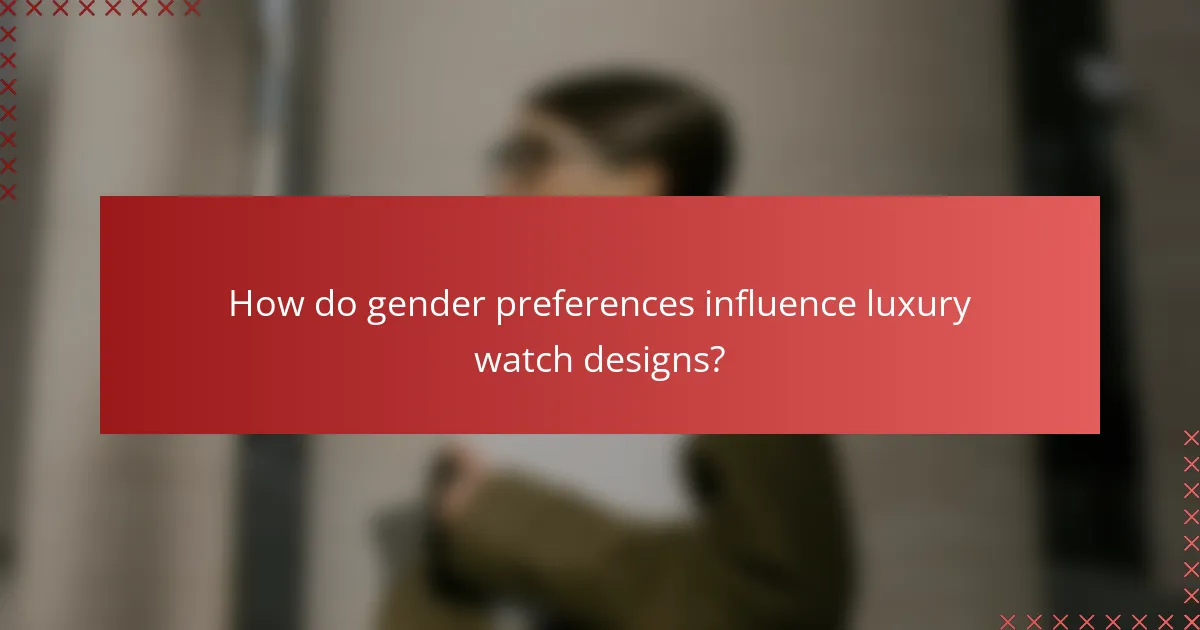The luxury watch market is experiencing a notable shift as female buyers increasingly enter the space, while male consumers are also redefining their preferences. This evolution reflects broader societal changes towards inclusivity and diverse expressions of luxury. As brands adapt their designs and marketing strategies to cater to these distinct tastes, factors such as brand reputation, quality, and price sensitivity play crucial roles in shaping consumer behavior.

What are the current gender trends in luxury watch purchases?
Current gender trends in luxury watch purchases show a significant increase in female buyers and evolving preferences among male consumers. These trends reflect broader societal shifts towards inclusivity and changing perceptions of luxury.
Increased female participation
Women are increasingly becoming key players in the luxury watch market, with many brands actively targeting this demographic. Female consumers now account for a notable percentage of high-end watch purchases, often seeking pieces that combine elegance with functionality.
Brands are responding by designing watches that appeal to women’s tastes, featuring smaller case sizes, vibrant colors, and unique materials. This shift not only reflects changing consumer preferences but also encourages brands to create more diverse collections.
Shifts in male preferences
Men’s preferences in luxury watches are evolving, with a growing interest in unique designs and smart features. Traditional styles are still popular, but many men are now gravitating towards watches that offer personalization and technological integration.
Brands are adapting by introducing hybrid models that blend classic aesthetics with modern technology, catering to a younger audience that values both style and functionality. This trend highlights a desire for watches that serve as both fashion statements and practical tools.
Impact of social media influencers
Social media influencers play a crucial role in shaping gender trends in luxury watch purchases. Their endorsements can significantly impact brand visibility and consumer choices, particularly among younger demographics.
Influencers often showcase luxury watches in lifestyle contexts, making them more relatable and desirable. This exposure can drive demand, as followers seek to emulate the styles and preferences of their favorite personalities, leading to increased sales across various brands.

How do gender preferences influence luxury watch designs?
Gender preferences significantly shape luxury watch designs, impacting aesthetics, functionality, and marketing strategies. Brands often tailor their offerings to appeal to the distinct tastes and needs of male and female consumers.
Gender-specific features
Luxury watches often incorporate gender-specific features that cater to the preferences of different demographics. For instance, men’s watches typically emphasize larger case sizes and robust materials, while women’s models may focus on elegance, with smaller cases and intricate detailing.
Additionally, functionality can vary; men’s watches may include features like chronographs and dive capabilities, whereas women’s watches often prioritize style and may include decorative elements like gemstones.
Color and style preferences
Color and style preferences play a crucial role in the design of luxury watches. Men generally gravitate towards classic colors such as black, silver, and blue, while women often prefer softer hues like rose gold, pastel shades, or vibrant colors that reflect current fashion trends.
Style choices also differ, with men favoring sporty or minimalist designs, while women may opt for more ornate styles that incorporate floral motifs or artistic elements.
Brand collaborations
Brand collaborations have become a strategic approach to cater to gender preferences in luxury watches. Many brands partner with fashion designers or celebrities to create limited-edition pieces that resonate with specific audiences. These collaborations often highlight unique design elements that appeal to gender-specific tastes.
For example, a collaboration between a luxury watch brand and a female fashion icon may result in a watch that features a delicate design and feminine colors, attracting female consumers looking for both style and prestige.

What are the key factors driving purchase behavior in luxury watches?
Key factors influencing purchase behavior in luxury watches include brand reputation, quality and craftsmanship, and price sensitivity. These elements shape consumer decisions and preferences, ultimately impacting sales in the luxury watch market.
Brand reputation
Brand reputation plays a crucial role in the luxury watch market, as consumers often associate well-known brands with prestige and quality. A strong brand image can enhance perceived value, making customers more willing to invest in a timepiece.
Luxury watch brands like Rolex and Patek Philippe have established themselves through decades of excellence and marketing. Buyers often seek brands with a rich heritage and a reputation for reliability, which can justify higher prices.
Quality and craftsmanship
The quality and craftsmanship of luxury watches are significant factors that drive purchase behavior. Consumers expect exceptional materials, precision engineering, and meticulous attention to detail in high-end timepieces.
For instance, watches made from stainless steel, gold, or platinum with intricate movements and hand-finished components are highly sought after. Buyers often evaluate these aspects to ensure their investment reflects superior craftsmanship.
Price sensitivity
Price sensitivity varies among luxury watch consumers, with some willing to pay a premium for exclusivity while others may seek value within a certain range. Understanding personal budget constraints is essential when considering a luxury watch purchase.
While some luxury watches can range from a few thousand to several hundred thousand dollars, many consumers look for models that offer a balance between quality and price. It’s advisable to set a budget and research options within that range to avoid overspending.

How does marketing affect gender-based buying decisions?
Marketing significantly influences gender-based buying decisions by shaping perceptions and preferences around luxury watches. Tailored messages and strategies can effectively target different demographics, leading to distinct purchasing behaviors among men and women.
Targeted advertising strategies
Targeted advertising strategies focus on creating tailored messages that resonate with specific gender audiences. For example, ads for luxury watches aimed at women may emphasize elegance and style, while those for men might highlight durability and performance. Utilizing data analytics can help brands identify key demographics and optimize their marketing efforts accordingly.
Brands often employ platforms like social media and search engines to reach their desired audience through targeted ads. By analyzing user behavior and preferences, companies can refine their strategies to enhance engagement and conversion rates.
Influence of celebrity endorsements
Celebrity endorsements play a crucial role in shaping gender-based buying decisions in the luxury watch market. When a well-known figure promotes a watch brand, it can create a sense of aspiration and desirability, particularly if the celebrity aligns with the target audience’s values. For instance, female celebrities may attract women buyers by showcasing watches that reflect sophistication.
Moreover, the effectiveness of endorsements can vary by gender; men may respond more positively to endorsements from male athletes or business leaders, while women may prefer endorsements from fashion icons or actresses. This highlights the importance of selecting the right celebrity to maximize impact.
Gender-neutral marketing approaches
Gender-neutral marketing approaches aim to appeal to a broader audience by avoiding traditional gender stereotypes. This strategy can be particularly effective in the luxury watch market, where consumers increasingly seek products that reflect personal style rather than conforming to gender norms. Brands may use inclusive language and imagery to attract diverse customers.
Implementing gender-neutral marketing can involve showcasing watches in a way that highlights their versatility and universal appeal. For example, campaigns that feature a mix of models wearing the same watch can demonstrate that luxury watches are for everyone, regardless of gender. This approach can enhance brand loyalty and attract a wider customer base.

What are the emerging trends in luxury watches for different genders?
Emerging trends in luxury watches reflect a growing emphasis on sustainability, technology, and personalization, appealing to diverse preferences across genders. As consumers become more conscious of their choices, brands are adapting to meet these evolving demands.
Sustainability in design
Sustainability has become a key focus in luxury watch design, with brands increasingly using eco-friendly materials and ethical sourcing practices. Consumers are drawn to watches made from recycled metals, sustainable leather alternatives, and conflict-free gemstones.
For example, some brands now offer timepieces crafted from biodegradable materials or those that adhere to strict environmental standards. This trend not only reduces environmental impact but also resonates with consumers who prioritize ethical consumption.
Smartwatch integration
The integration of smartwatch technology into luxury timepieces is gaining traction, appealing to tech-savvy consumers. Many luxury brands are now incorporating smart features such as fitness tracking, notifications, and customizable watch faces into their traditional designs.
This blend of classic aesthetics with modern functionality allows consumers to enjoy the elegance of a luxury watch while benefiting from the convenience of smart technology. However, potential buyers should consider battery life and compatibility with their devices when choosing a smartwatch-integrated model.
Customization options
Customization is increasingly popular among luxury watch buyers, allowing individuals to create a unique timepiece that reflects their personal style. Many brands now offer options for engraving, interchangeable straps, and bespoke designs tailored to individual preferences.
When considering customization, consumers should explore the range of options available and the potential impact on resale value. Personalized watches can enhance emotional attachment but may limit market appeal if the design is too niche.

How do cultural factors shape luxury watch preferences?
Cultural factors significantly influence luxury watch preferences by shaping perceptions of status, aesthetics, and functionality. Different regions prioritize distinct attributes, such as craftsmanship, brand heritage, or innovative technology, impacting consumer choices.
Regional Aesthetics and Symbolism
In various cultures, the aesthetics of luxury watches can vary widely. For instance, Asian markets often favor watches with intricate designs and symbolism, reflecting cultural values such as prosperity and longevity. In contrast, Western consumers may lean towards minimalist designs that emphasize modernity and sophistication.
Brand Heritage and Status
Brand heritage plays a crucial role in luxury watch preferences. In Europe, brands with a long history and traditional craftsmanship, like Swiss watchmakers, are often seen as more prestigious. Meanwhile, in emerging markets, newer brands that resonate with contemporary trends can gain rapid popularity, appealing to a younger demographic eager for status symbols.
Functionality and Technology
Different cultures also prioritize functionality in luxury watches differently. For example, consumers in the United States may value smart features and versatility, while European buyers might prefer classic mechanical movements that showcase artistry. This divergence affects how brands market their products and the features they emphasize.
Social Influences and Trends
Social influences, including celebrity endorsements and social media trends, can sway luxury watch preferences. In many cultures, seeing a watch worn by a popular figure can significantly boost its desirability. Brands often leverage these influences to align their products with current trends and consumer aspirations.
